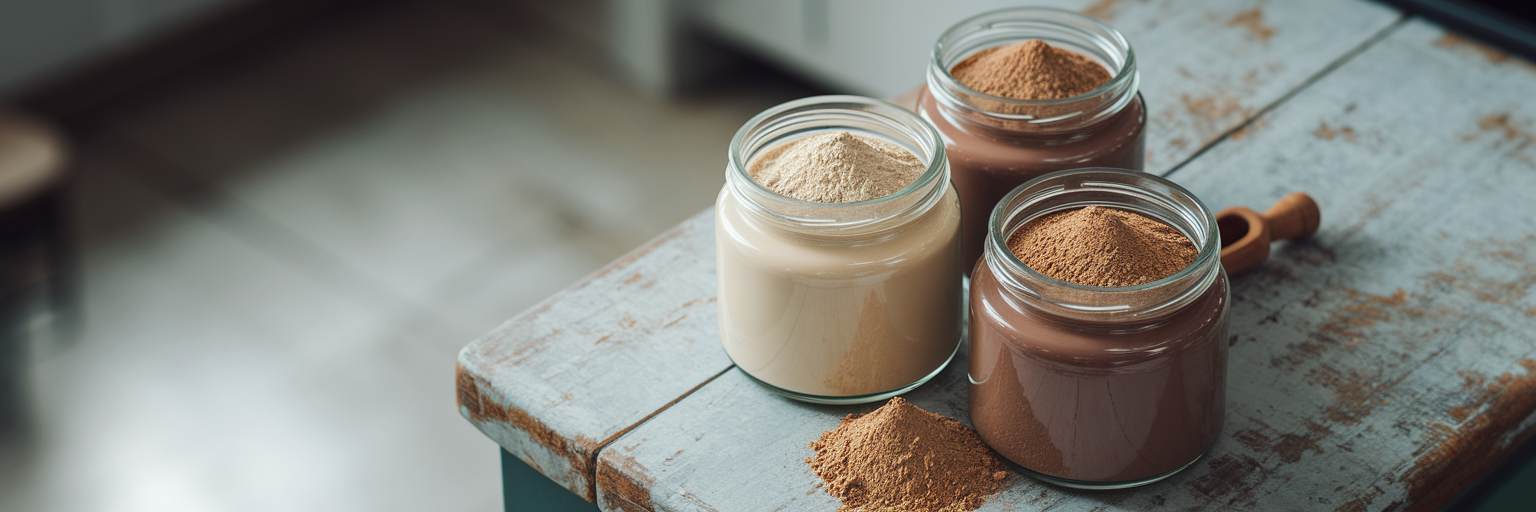Why Protein Powder Belongs in Your Desserts
Let's be honest, most of us see protein powder as something to chug down after a workout. We mix it with water, hold our breath, and get on with our day. But what if it could be a key ingredient in your favorite treats? Adding protein to your desserts isn't about restriction. It's about making those treats work harder for you.
Imagine a brownie that actually keeps you full for hours or a cookie that supports your fitness goals. That’s the magic of baking with protein. By swapping out some of the flour and sugar, you create low calorie dessert recipes that are satisfying and delicious. Protein helps with satiety, meaning you feel fuller longer and are less likely to overindulge. This simple switch transforms a guilty pleasure into a smart snack.
For busy people, this is a fantastic shortcut. Instead of spending hours on complex recipes, you can whip up a protein-packed treat in minutes. It’s a convenient way to satisfy a sweet tooth without derailing your nutrition. This is just one of many ways to use protein powder in the kitchen, and we're always exploring other creative recipes to make healthy eating enjoyable.
Selecting Your Perfect Vegan Protein Powder

Before you start baking, it’s important to know that not all vegan protein powders are created equal. The type you choose will have a big impact on the final texture and taste of your vegan protein powder desserts. Think of this as your personal buying guide.
Some powders are smooth and neutral, while others can be gritty or have a strong, earthy flavor. Understanding these differences is the first step to avoiding a baking fail. For beginners, starting with a pre-flavored powder can make things much easier. A well-formulated chocolate vegan protein, for example, already has the sweetness and flavor balanced for you. If you're more adventurous, an unflavored powder offers a blank canvas for your own creativity.
Always check the ingredient list. Many powders are loaded with hidden sugars, gums, and fillers that can ruin both the taste and the nutritional profile of your dessert. A clean, simple formula will always yield better results.
| Protein Type | Texture in Baking | Flavor Profile | Best For |
|---|---|---|---|
| Pea Protein | Can be dense; absorbs liquid | Earthy, distinct | Brownies, cookies, denser cakes |
| Soy Protein | Smooth, helps with browning | Relatively neutral | Cakes, muffins, all-purpose baking |
| Brown Rice Protein | Slightly gritty or sandy | Mildly sweet, nutty | Crumbles, crisps, no-bake bars |
| Hemp Protein | Coarser, adds texture | Nutty, earthy | Muffins, rustic breads, energy bites |
| Protein Blends | Balanced, smooth, less chalky | Often neutral or pre-flavored | Most versatile; good for beginners |
Note: This table provides general characteristics. The performance of each powder can vary by brand and formulation. Experimentation is key to finding what works best for your recipes.
Core Techniques for Protein-Packed Baking
Once you have your powder, it's time to learn the rules of the road. Baking with protein isn't difficult, but it does require a few adjustments. Protein powder is not a one-to-one replacement for flour, and understanding why will save you from a lot of frustration. Here is a simple guide on how to bake with protein powder and get it right every time.
- The Flour Replacement Rule: Don't go all in. Start by substituting only about one-quarter to one-third of the flour in a recipe with protein powder. As the baking experts at Vega suggest, this ratio helps maintain a good structure without making the final product too dense or dry.
- Boost Moisture and Fat: Protein powder is hygroscopic, which is a fancy way of saying it loves to soak up liquid. To counteract this, you must add extra moisture. Mashed banana, unsweetened applesauce, pumpkin puree, or a scoop of plant-based yogurt are all excellent choices. A little healthy fat from nut butter or avocado also works wonders for creating a soft, tender texture.
- Avoid Overmixing: This might be the most important rule. As soon as you add the protein powder to your wet ingredients, mix the batter just until everything is combined. If you keep stirring, you'll develop the gluten and protein strands, resulting in a tough, rubbery dessert. We’ve all been there.
- Don't Forget to Leaven: Protein powder is heavy and can weigh down a batter. To give your desserts the light, airy crumb you're looking for, add a little extra baking powder or baking soda. This gives your creation the lift it needs to rise properly.
Simple Vegan Protein Dessert Recipes to Try

Now for the fun part. With the basic techniques down, you can start turning your favorite treats into healthy vegan dessert ideas. You don't need to be a pastry chef to make something incredible. Here are a few simple concepts to get you started and inspire your next kitchen adventure.
The 5-Minute Protein Mug Cake
When a sweet craving hits, nothing beats a protein powder mug cake. It’s the ultimate single-serving dessert that you can make in minutes. Simply mix a scoop of your favorite flavored protein powder with a little plant-based milk, a touch of applesauce for moisture, and a pinch of baking powder. Microwave for about a minute, and you have a warm, fluffy cake ready to enjoy. You can customize it with chocolate chips, berries, or a spoonful of nut butter on top.
Fudgy High-Protein Brownies
Forget dry, cakey protein brownies. The secret to a truly fudgy texture is using ingredients that add both moisture and richness. Combine your protein powder with mashed ripe banana, creamy almond butter, and a bit of cocoa powder. The banana acts as a natural sweetener and binder, while the nut butter provides healthy fats that create that melt-in-your-mouth feel. These brownies are dense, decadent, and packed with enough protein to be a legitimate post-workout snack.
Creamy No-Bake Protein Pudding
If baking isn't your thing, this no-bake pudding is a lifesaver. Just blend a scoop of vanilla or chocolate vegan protein powder with a plant-based yogurt or silken tofu until it's completely smooth. The protein powder will thicken the base, creating a rich, creamy consistency similar to a traditional pudding or mousse. Let it chill in the fridge for about 30 minutes to set. It's an incredibly easy and refreshing treat. For more detailed instructions, check out our post on 3 Easy Vegan Protein Recipes You'll Actually Crave.
Mastering Natural Sweetness and Flavor
One of the biggest challenges with healthy baking is achieving the right level of sweetness without relying on refined sugar. Fortunately, nature provides plenty of delicious alternatives that also add nutritional value to your vegan protein powder desserts. It's all about learning how to layer flavors to create a satisfying experience.
Your goal is to build sweetness and depth from multiple sources. Here are a few go-to options:
- Liquid Natural Sweeteners: Maple syrup, agave nectar, and date syrup are fantastic choices. They not only add sweetness but also contribute to a moist texture. Each one brings its own unique flavor profile. Maple syrup adds a warm, caramel note, while date syrup offers a rich, fruity depth that pairs beautifully with chocolate.
- Whole Food Sweeteners: Very ripe bananas are a baker's best friend. They provide sweetness, moisture, and act as a binder. Unsweetened applesauce and pumpkin puree are other great options that add nutrients and help create a soft, tender crumb.
- Calorie-Free Flavor Enhancers: Never underestimate the power of spices and extracts. Cinnamon, nutmeg, and cardamom can create a warm, sweet-smelling dessert that tricks your palate into perceiving more sweetness. A splash of high-quality vanilla or almond extract can also add a layer of complexity and richness without any sugar.
Troubleshooting Common Protein Dessert Fails
Even with the best intentions, sometimes a recipe just doesn't turn out right. Don't get discouraged. Most protein baking fails are caused by a few common issues that are easy to fix. Here’s a quick guide to help you troubleshoot and build your confidence.
Problem: My Dessert is Dry and Crumbly
This is the most common complaint. The likely cause is not enough liquid or fat to balance the absorbent nature of the protein powder. The solution is simple: next time, add an extra splash of plant-based milk or a tablespoon of applesauce, pumpkin puree, or nut butter.
Problem: My Dessert is Rubbery and Dense
If your dessert has the texture of a hockey puck, you probably overmixed the batter. Once the protein powder is in, you want to stir just until the ingredients are combined and then stop. Less is more. This prevents the proteins from forming a tough, chewy network.
Problem: My Dessert Tastes Gritty or Chalky
A gritty texture is almost always due to the quality of the protein powder itself. Some powders are not milled finely enough and won't dissolve completely. The solution is to invest in a high-quality, finely milled powder. It makes a world of difference. You can start by exploring a collection of high-quality powders designed for a smooth finish.



